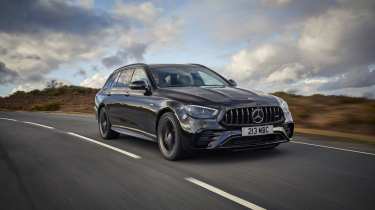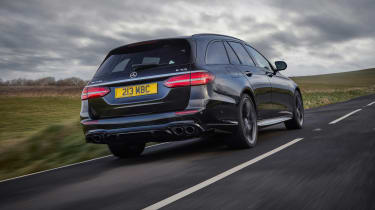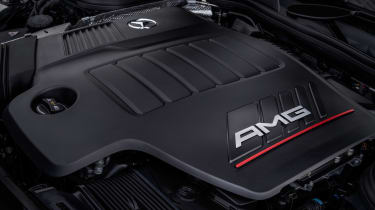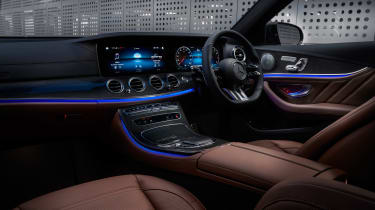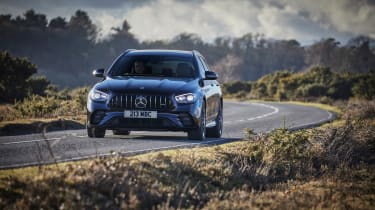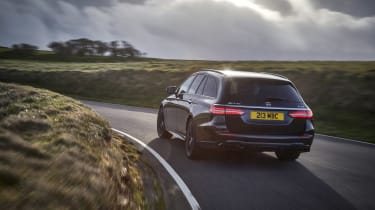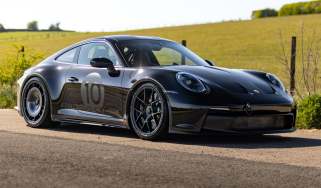Mercedes-AMG E53 2021 review – brimming with tech, but missing the charisma of an M550i
A superbly built premium estate with just enough performance pep to get the blood flowing – this is no E63-lite, but also does without its compromises
The E53 was a groundbreaking car for Mercedes-Benz when it first arrived in 2018. Powered by a brand new mild-hybrid 3-litre straight-six petrol engine, it had both a gas-driven turbocharger and an electrically powered compressor, technology all right at the cutting edge of engine design. It really did feel like Mercedes (not AMG, mind) was throwing its full and considerable weight behind what it felt was the future of internal combustion engines.
Three years later, mild hybridisation has now been applied right across the Mercedes engine range, and with the imminent arrival of a new generation of electrified powertrains from AMG you have to wonder whether the E53 AMG is already feeling a little out of date. Or is it instead a fine balance between future-proofed internal combustion engineering and old-school charm?
Engine, transmission and 0-60 time
The M256 3-litre straight-six petrol engine was introduced in 2017 as a cutting-edge replacement for Merc’s old V6 units. Straight from the off it was packed with tech, with all versions incorporating a mild-hybrid system made up of a 48V electrical system and an integrated starter generator (ISG) with 22bhp and 184lb ft of torque. In the E53 this system also powered a BorgWarner electrically driven supercharger, in addition to a traditional exhaust-driven twin-scroll turbocharger.
More reviews
In-depth reviews
Reviews
- Mercedes-Benz E55 AMG (W211, 2003 - 2006): review, specs and buying guide
- Mercedes-AMG E53 Hybrid 4Matic+ 2024 review – AMG’s first long-distance hybrid tested
- Mercedes E-class 2024 review – plug-in hybrid E300e tested
- Mercedes E-class 2020 review – new E450 a smooth operator
- New Mercedes-Benz E-class review
- Mercedes E400d AMG-Line estate review
Peak figures are rated at 429bhp between 5500 and 6500rpm, with 383lb ft of torque available from just 1800rpm, keeping steady until 5800rpm. The engine is connected exclusively to a nine-speed torque converter automatic transmission, with power sent to all four wheels via a rear-biased all-wheel-drive system. A kerb weight of 2025kg means acceleration is blunted slightly compared to the raucous V8 models, but 4.5sec to 62mph is still plenty quick enough. Ironically, despite all its eco-friendly hybrid tech, MPG is still only rated at around 30mpg on a combined cycle.
Technical highlights
Away from the engine the E53’s chassis is actually fairly standard by sport saloon standards, with a four-link front and a multi-link rear suspension design on air springs and adaptive dampers all round. The estate also has a self-levelling function on the rear axle.
The E53 includes AMG’s endless combination of driver modes which, despite their complexity, are easy enough to modify on the go thanks to separate switches on the centre console. Let’s also get the new steering wheel out of the way – it’s a total mess, with 22 individual touch-sensitive controllers and two sliders on its four spokes that do everything from control the cruise control to give you access to the deep, dark depths of the MBUX infotainment system. A pure, clean and functional piece of design it’s not.
When you’re in the infotainment system you might also find yourself in odd places after a few inadvertent button presses. One such exercise turned the infotainment screen into a fireplace, switched on the hot stone massage seats, closed the rear window shades and started playing what an automotive engineer might constitute as make-out music. It was weird.
What’s it like to drive?
Stop playing around with the E53’s boudoir settings and what you’re left with is a reminder of how good top-drawer combustion engineering can be. The powertrain on start-up does give you a gratuitous bark through the four exhaust pipes, but otherwise settles into a sophisticated hum that sounds and feels expensive.
Every bit of initial feedback feels as oily smooth as the inky black paintwork of this test car, with an impressive rate of response from the steering – Mercedes really has become very good at sorting its steering racks – and superb calibration between the throttle and gearbox.
Play around with the drive modes and the straight-six becomes more vocal, and while the 383lb ft torque figure might sound nothing more than average for the sort used to big-hitting diesels, the full hit from just 1800rpm makes it feel incredibly strong as soon as you hit the pedal, making good use of the electrically driven compressor and ISG at low engine speeds.
Despite the 20-inch wheels it also rides very well over broken surfaces, and while there isn’t quite as much detailed connection to the road surface on account of the air springs, there’s not a touch of wallow or uncontrolled lateral movement to the body, only the slightest hint of a shudder when you hit a more substantial intrusion.
Up the pace and the E53 really hits its stride though. The steering, while always faithful, now offers real reassurance and feel that gives you plenty of confidence as you load the front axle. Get greedy with the throttle and the all-wheel-drive system is always far too comprehensive to get any trouble with rear axle traction, making it easy to get into a nice flow underpinned by plenty of lateral support.
Push harder and the front axle reveals its tenacity isn’t quite on a par with that of its more aggressive V8-powered AMG siblings, but compared to its key BMW M550i rival’s steering, the E53’s does feel more natural. Where it doesn’t keep up with the BMW is outright chassis balance, as the BMW’s extra lateral support allows you to lean on the chassis more intently, revealing its more playful edge. It also feels more generously rear-wheel drive, and while the Merc’s straight-six has plenty of grunt the BMW’s 523bhp V8 hits much harder and with a desirable offbeat rumble alongside.
The Merc’s straight-six has its own appeal with a cultured, sometimes shrill note that suits the E53’s understated character. Open a few windows and you’re soon met with a symphony of other noises otherwise muted from the cabin, including all sorts of chirruping and even a subtle electric whine from the engine bay ahead. There’s also an odd little burp on downshifts that sounds like a drunk child is hiding somewhere under the boot floor – it’s all very entertaining, but ultimately less satisfying than the BMW’s V8.
Price and rivals
The E53 is available in two specifications as both saloon and estate bodies starting at £65,555 and £67,555 respectively. Standard kit is plentiful, with 19-inch wheels, LED headlights, leather interior trim, the full MBUX infotainment set-up and all the usual safety and convenience features included. An extra £3500 will upgrade you to Night Edition spec, which removes most of the chrome trim but adds 20-inch wheels and tyres, upgraded headlights and stereo, parking assistance and a panoramic roof.
The E53’s two closest rivals sit on either side of it for price and specification, with BMW’s V8-powered M550i starting at £71,425, with a myriad of option packages that can take that price right up to around £90k. Audi’s £60,190 S6 TDi is powered by a MHEV V6 diesel, and is considerably outgunned by both the Merc and BMW on paper and on road, and you’ll still need to find an extra £20k on top for any meaningful chassis tech to match that of the BMW and AMG.

